Cicindela
| Cicindela | |
|---|---|
| Cicindela sexguttata | |
| Scientific classification | |
| Kingdom: | Animalia |
| Clade: | Euarthropoda |
| Class: | Insecta |
| Order: | Coleoptera |
| Family: | Carabidae |
| Subfamily: | Cicindelinae |
| Tribe: | Cicindelini |
| Subtribe: | Cicindelina |
| Genus: | Cicindela Linné, 1758 |
| Type species | |
| Cicindela campestris | |
| Subgenera and species | |
|
Many (see List of Cicindela species). | |
Cicindela, commonly known as common tiger beetles [1] are generally brightly colored and metallic beetles, often with some sort of patterning of ivory or cream-colored markings. They are most abundant and diverse in habitats very often near bodies of water with sandy or occasionally clay soils; they can be found along rivers, sea and lake shores, sand dunes, around dry lakebeds, on clay banks, or woodland paths.
Etymology
The word "Cicindela" comes from the Latin word "cicindela", meaning "glowworm". This comes from the fact that members of the genus Cicindela are metallic and sometimes flashing.[1]
Systematics
The genus Cicindela is (in its broadest historical sense) the largest genus of tiger beetles, and they occur worldwide. The status of the genus is constantly in a state of flux, as various authorities on different continents have vastly different opinions about which (if any) of the dozens of subgenera traditionally recognized within the genus are deserving of being accorded status as independent genera. Moreover, this is one of the few insect taxa in which the rank of subspecies has traditionally been used repeatedly, and essentially no two classifications consistently treat the various members of the genus as to which are species and which are subspecies.
Treated as a single genus, and even with a fairly conservative estimate of species, there are over 850 [2] (or even up to 2,300) species in the group [3] (thus being almost equal to the subtribe Cicindelina (W.Horn, 1908), with several thousand published names applied, collectively. Currently most of the subgenera below are in fierce dispute, being considered genera of their own by some, and subgenera of the genus Cicindela by others. The genus is divided into the following subgenera:
- Cicindela (Ancylia)
- Cicindela (Archidela)
- Cicindela (Austrocicindela)
- Cicindela (Brasiella)
- Cicindela (Calochroa)
- Cicindela (Cephalota)
- Cicindela (Chaetodera)
- Cicindela (Cicindela)
- Cicindela (Cicindelidia)
- Cicindela (Cylindera)
- Cicindela (Duponti)
- Cicindela (Euzona)
- Cicindela (Fulgoris)
- Cicindela (Habroscelimorpha)
- Cicindela (Hypaetha)
- Cicindela (Jansonia)
- Cicindela (Lophyridia)
- Cicindela (Macfarlandia)
- Cicindela (Micromentignatha)
- Cicindela (Myriochile)
- Cicindela (Neolaphyra)
- Cicindela (Opilidia)
- Cicindela (Pachydela)
- Cicindela (Pancallia)
- Cicindela (Rivacindela)
- Cicindela (Sophiodela)
- Cicindela (Tribonia)
For a list of species, see List of Cicindela species. The subgenus Cicindela (Cicindela), or Cicindela sensu stricto contains the following species:
- Cicindela albissima
- Cicindela altaica
- Cicindela ancocisconiensis
- Cicindela arenicola
- Cicindela asiatica
- Cicindela bellissima
- Cicindela campestris
- Cicindela clypeata
- Cicindela coerulea
- Cicindela colombica
- Cicindela decemnotata
- Cicindela denverensis
- Cicindela depressula
- Cicindela dorsalis
- Cicindela duodecimguttata
- Cicindela fabrici
- Cicindela formosa
- Cicindela fulgida
- Cicindela gallica
- Cicindela gemmata
- Cicindela granulata
- Cicindela hirticollis
- Cicindela hybrida
- Cicindela iberica
- Cicindela japana
- Cicindela kozhantschikovi
- Cicindela lacteola
- Cicindela lengi
- Cicindela lewisii
- Cicindela ligi
- Cicindela limbalis
- Cicindela limbata
- Cicindela longilabris
- Cicindela lusitanica
- Cicindela majalis
- Cicindela marginata
- Cicindela maroccana
- Cicindela nebraskana
- Cicindela nigrior
- Cicindela ohlone
- Cicindela oregona
- Cicindela parowana
- Cicindela patruela
- Cicindela plutonica
- Cicindela pugetana
- Cicindela pulchra
- Cicindela purpurea
- Cicindela repanda
- Cicindela resplendens
- Cicindela restricta
- Cicindela sachalinensis
- Cicindela sahlbergii
- Cicindela scutellaris
- Cicindela sexguttata
- Cicindela soluta
- Cicindela songorica
- Cicindela splendida
- Cicindela sylvatica
- Cicindela sylvicola
- Cicindela tenuicincta
- Cicindela theatina
- Cicindela tranquebarica
- Cicindela transbaicalica
- Cicindela turkestanika
- Cicindela waynei
- Use of the Cicindela elegans name
- Cicindela elegans Fourcroy & Geoffroy, 1785 is a synonym for Cephalota elegans, a species found in Russia.
- Cicindela elegans Dej. (described as "Cicindela elegans Dej. Spec I. 144. 123. De Java . Coll . de M. Payen" by Pierre Léonard Vander Linden in 1829[4][5] refers to a species found in Java. The description given by Dejean is
- "C. Versicolor Mac Leay. Annulosa Javanica. I. p. 11. n°7.", whereas that given by Macleay is
- "7. VERSICOLOR. C. atrocaeruleus thorace bis constricto elytris atris, apice violaceis; margine maculis tribus viridiaeneis. Long. corp. 5/16 +
- Insectum nitidum generi praecedenti proximum. Caput atrocaeruleum rugis striatum fronte depresso oculis magnis prominentibus. Labrum viride. Mandibulae testaceae apice nifrae. Pulpi testacei articulis duobus ultimis viridibus. Antennae nigrae basi caerulae. Thorax THERATIS latere posticéque viridis. Elytra trimaculata maculis viridibus marginalibus; humerali elongata posticé, media transversa, posticaque triangulari. Corpus subtus caeruleum. Pedes atrocaerulei.".
Gallery
 Cicindela depressula ssp depressula
Cicindela depressula ssp depressula Cicindela duponti
Cicindela duponti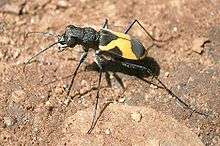
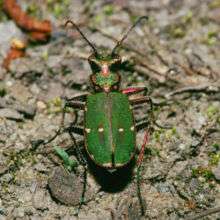
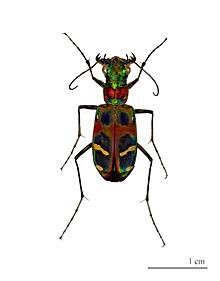 Cicindela chinensis
Cicindela chinensis
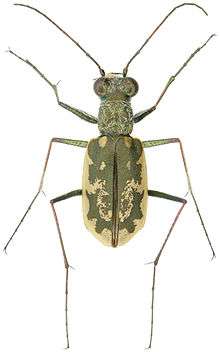 Cicindela marginata
Cicindela marginata
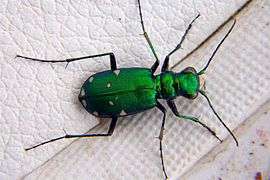


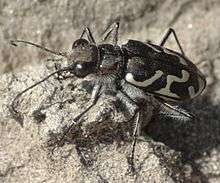
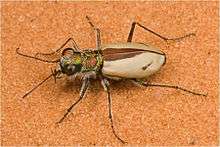
Notes
- 1 2 "Genus Cicindela". Bugguide. Retrieved January 21, 2015.
- ↑ Cardoso, A, Vogler, A.P. DNA taxonomy, phylogeny and Pleistocene diversification of the Cicindela hybrida species group (Coleoptera: Cicindelidae). Molecular Ecology (2005) 14, 3531–3546
- ↑ Proença,S.J.R,Cytogenetic variability in three species of the genus Cicindela (s.l.) (Coleoptera, Cicindelidae): Karyotypes and localization of 18S rDNA genes.Genetics and Molecular Biology, 27, 4, 555-560 (2004)
- ↑ Essai sur les insects de Java et des îles voisines. PL Vander Linden, Nouveaux mémoires de l'Académie Royale Sciences et Belles-Lettres de Bruxelles, Volume 5, pages 1-28, 1829, description page 16 (link)
- ↑ Species général des coléoptères, de la collection de M. le comte Dejean, Volume 2. Pierre François Marie Auguste Dejean
References
- Northeastern Tiger Beetles: A Field Guide to Tiger Beetles of New England and Eastern Canada by Jonathan G. Leonard and Ross T. Bell. CRC Press (1999).
- Tiger Beetles of Alberta: Killers on the Clay, Stalkers on the Sand by John Acorn. University of Alberta Press, 2001.
- Tiger Beetles: The Evolution, Ecology, and Diversity of the Cicindelids by David L. Pearson and Alfried P. Vogler. Cornell University Press, 2001.
- A Field Guide to the Tiger Beetles of the United States and Canada by David L. Pearson, C. Barry Knisley and Charles J. Kazilek. Oxford University Press, 2005.